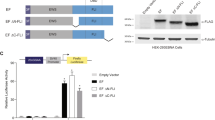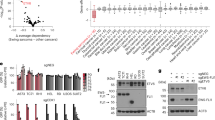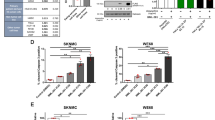Abstract
In the majority of Ewing’s family tumors, chromosomal translocation t(11;22) leads to aberrant fusion of RNA-binding protein EWS with DNA-binding ETS transcriptional factor Fli-1. EWS-Fli-1 has altered the transcriptional activity and modulating its downstream target genes through this transcriptional activity is thought to be responsible for this tumor. We have previously shown that both EWS-Fli-1 and Fli-1 have antiapoptotic activity against several apoptotic inducers. Here, we show that the transcriptional activity of EWS-Fli-1 and Fli-1 is not essential for its antiapoptotic activity. We also demonstrate that EWS-Fli-1 and Fli-1 interact with CBP through its amino-terminal region and inhibit the CBP-dependent transcriptional activity of RXR. This activity appears to be independent of DNA-binding activity of EWS-Fli-1. Introduction of the dominant-negative form of CBP into Ewing’s sarcoma cells sensitizes these cells against genotoxic or retinoic-acid induced apoptosis. These results suggest that the ability of EWS-Fli-1/Fli-1 to target transcriptional cofactor(s) and modulate apoptotic pathways may be responsible for its antiapoptotic and tumorigenic activities.
This is a preview of subscription content, access via your institution
Access options
Subscribe to this journal
Receive 50 print issues and online access
$259.00 per year
only $5.18 per issue
Buy this article
- Purchase on Springer Link
- Instant access to full article PDF
Prices may be subject to local taxes which are calculated during checkout




Similar content being viewed by others
References
Araya N, Hirota K, Shimamoto Y, Miyagishi M, Yoshida E, Ishida J, Kaneko S, Kaneko M, Nakajima T and Fukamizu A . (2003). J. Biol. Chem., 278, 5427–5432.
Arvand A and Denny CT . (2001). Oncogene, 20, 5747–5754.
Avantaggiati ML, Ogryzko V, Gardner K, Giordano A, Levine AS and Kelly K . (1997). Cell, 89, 1175–1184.
Borrow J, Stanton Jr VP, Andresen JM, Becher R, Behm FG, Chaganti RS, Civin CI, Disteche C, Dube I, Frischauf AM, Horsman D, Mitelman F, Volinia S, Watmore AE and Housman DE . (1996). Nat. Genet., 14, 33–41.
Canaani E, Nakamura T, Rozovskaia T, Smith ST, Mori T, Croce CM and Mazo A . (2004). Br. J. Cancer, 90, 756–760.
Darby TG, Meissner JD, Ruhlmann A, Mueller WH and Scheibe RJ . (1997). Oncogene, 15, 3067–3082.
Deneen B, Welford SM, Ho T, Hernandez F, Kurland I and Denny CT . (2003). Mol. Cell. Biol., 23, 3897–3908.
Dhulipala PD, Lee L, Rao VN and Reddy ES . (1998). Oncogene, 17, 1149–1157.
Fujimura Y, Siddique H, Lee L, Rao VN and Reddy ES . (2001). Oncogene, 20, 6653–6659.
Gauthier JM, Bourachot B, Doucas V, Yaniv M and Moreau-Gachelin F . (1993). EMBO J., 12, 5089–5096.
Gayther SA, Batley SJ, Linger L, Bannister A, Thorpe K, Chin SF, Daigo Y, Russell P, Wilson A, Sowter HM, Delhanty JD, Ponder BA, Kouzarides T and Caldas C . (2000). Nat. Genet., 24, 300–303.
Goodman RH and Smolik S . (2000). Genes Dev., 14, 1553–1577.
Hamamori Y, Sartorelli V, Ogryzko V, Puri PL, Wu HY, Wang JY, Nakatani Y and Kedes L . (1999). Cell, 96, 405–413.
Hong W, Kim AY, Ky S, Rakowski C, Seo SB, Chakravarti D, Atchison M and Blobel GA . (2002). Mol. Cell. Biol., 22, 3729–3743.
Jaishankar S, Zhang J, Roussel MF and Baker SJ . (1999). Oncogene, 18, 5592–5597.
Javelaud D, Wietzerbin J, Delattre O and Besancon F . (2000). Oncogene, 19, 61–68.
Kamei Y, Xu L, Heinzel T, Torchia J, Kurokawa R, Gloss B, Lin SC, Heyman RA, Rose DW, Glass CK and Rosenfeld MG . (1996). Cell, 85, 403–414.
Kawasaki H, Eckner R, Yao TP, Taira K, Chiu R, Livingston DM and Yokoyama KK . (1998). Nature, 393, 284–289.
Kovar H, Aryee DN, Jug G, Henockl C, Schemper M, Delattre O, Thomas G and Gadner H . (1996). Cell Growth Differ., 7, 429–437.
Kung AL, Rebel VI, Bronson RT, Ch’ng LE, Sieff CA, Livingston DM and Yao TP . (2000). Genes Dev., 14, 272–277.
Lee CW, Sorensen TS, Shikama N and La Thangue NB . (1998). Oncogene, 16, 2695–2710.
Lill NL, Grossman SR, Ginsberg D, DeCaprio J and Livingston DM . (1997). Nature, 387, 823–827.
Martini A, La Starza R, Janssen H, Bilhou-Nabera C, Corveleyn A, Somers R, Aventin A, Foa R, Hagemeijer A, Mecucci C and Marynen P . (2002). Cancer Res., 62, 5408–5412.
May WA, Gishizky ML, Lessnick SL, Lunsford LB, Lewis BC, Delattre O, Zucman J, Thomas G and Denny CT . (1993). Proc. Natl. Acad Sci. USA, 90, 5752–5756.
Miller RW and Rubinstein JH . (1995). Am. J. Med. Genet., 56, 112–115.
Ohno T, Ouchida M, Lee L, Gatalica Z, Rao VN and Reddy ES . (1994). Oncogene, 9, 3087–3097.
Ohno T, Rao VN and Reddy ES . (1993). Cancer Res., 53, 5859–5863.
Ouchida M, Ohno T, Fujimura Y, Rao VN and Reddy ES . (1995). Oncogene, 11, 1049–1054.
Petermann R, Mossier BM, Aryee DN, Khazak V, Golemis EA and Kovar H . (1998). Oncogene, 17, 603–610.
Petrij F, Giles RH, Dauwerse HG, Saris JJ, Hennekam RC, Masuno M, Tommerup N, van Ommen GJ, Goodman RH, Peters DJM and Breuning MH . (1995). Nature, 376, 348–351.
Prasad DD, Ouchida M, Lee L, Rao VN and Reddy ES . (1994a). Oncogene, 9, 3717–3729.
Prasad DD, Rao VN and Reddy ES . (1992). Cancer Res., 52, 5833–5837.
Prasad DD, Rao VN, Lee L and Reddy ES . (1994b). Oncogene, 9, 669–673.
Rao VN, Ohno T, Prasad DD, Bhattacharya G and Reddy ES . (1993). Oncogene, 8, 2167–2173.
Rao VN, Papas TS and Reddy ES . (1987). Science, 237, 635–639.
Reddy ES, Rao VN and Papas TS . (1987). Proc. Natl. Acad Sci. USA, 84, 6131–6135.
Rossow KL and Janknecht R . (2001). Cancer Res., 61, 2690–2695.
Sargiannidou I, Qiu C and Tuszynski GP . (2004). Semin. Thromb. Hemost., 30, 127–136.
Sarrazin S, Bonod-Bidaud C, Remy P, Mehlen P and Morle F . (2002). Biochim. Biophys. Acta, 1592, 123–127.
Satake N, Ishida Y, Otoh Y, Hinohara S, Kobayashi H, Sakashita A, Maseki N and Kaneko Y . (1997). Genes Chromosomes Cancer, 20, 60–63.
Shen W, Krishnan K, Lawrence HJ and Largman C . (2001). Mol. Cell. Biol., 21, 7509–7522.
Siddique HR, Rao VN, Lee L and Reddy ES . (1993). Oncogene, 8, 1751–1755.
So CW and Cleary ML . (2002). Mol. Cell. Biol., 22, 6542–6552.
Sobulo OM, Borrow J, Tomek R, Reshmi S, Harden A, Schlegelberger B, Housman D, Doggett NA, Rowley JD and Zeleznik-Le NJ . (1997). Proc. Natl. Acad. Sci. USA, 94, 8732–8737.
Soldatenkov VA, Trofimova IN, Rouzaut A, McDermott F, Dritschilo A and Notario V . (2002). Oncogene, 21, 2890–2895.
Tanaka K, Iwakuma T, Harimaya K, Sato H and Iwamoto Y . (1997). J. Clin. Invest., 99, 239–247.
Truong T and Ben-David Y . (2000). Oncogene, 19, 6482–6489.
Wang H, Shao N, Ding QM, Cui J, Reddy ES and Rao VN . (1997). Oncogene, 15, 143–157.
Welford SM, Hebert SP, Deneen B, Arvand A and Denny CT . (2001). J. Biol. Chem., 11, 11.
Yang L, Chansky HA and Hickstein DD . (2000a). J. Biol. Chem., 275, 37612–37618.
Yang L, Embree LJ and Hickstein DD . (2000b). Mol. Cell. Biol., 20, 3345–3354.
Yi H, Fujimura Y, Ouchida M, Prasad DD, Rao VN and Reddy ES . (1997). Oncogene, 14, 1259–1268.
Yuan ZM, Huang Y, Ishiko T, Nakada S, Utsugisawa T, Shioya H, Utsugisawa Y, Shi Y, Weichselbaum R and Kufe D . (1999). Oncogene, 18, 5714–5717.
Zhao F, McCarrick-Walmsley R, Akerblad P, Sigvardsson M and Kadesch T . (2003). Mol. Cell. Biol., 23, 3837–3846.
Zhou RR, Jia SF, Zhou Z, Wang Y, Bucana CD and Kleinerman ES . (2002). Cancer Gene Ther., 9, 407–413.
Zhou Z, Jia SF, Hung MC and Kleinerman ES . (2001). Cancer Res., 61, 3394–3398.
Acknowledgements
We thank R Class for his assistance in the FACS analysis and other colleagues of Reddy and Rao's laboratories for their cooperation throughout this study. We also thank Professor Pierre Chambon for providing us generously mRXR and DR5G-tk CAT plasmids. This work was supported in part by NIH grants RO1 CA 85642, RO1 CA 85343 and US Army medical research grant DAMD 17-99-1-9060 and GCC Distinguished Cancer Scholar award to ESP Reddy and CA 57322 to CA 83591 and GCC Distinguished Cancer Scholar award to VN Rao.
Author information
Authors and Affiliations
Corresponding author
Rights and permissions
About this article
Cite this article
Ramakrishnan, R., Fujimura, Y., Zou, J. et al. Role of protein–protein interactions in the antiapoptotic function of EWS-Fli-1. Oncogene 23, 7087–7094 (2004). https://doi.org/10.1038/sj.onc.1207927
Received:
Revised:
Accepted:
Published:
Issue Date:
DOI: https://doi.org/10.1038/sj.onc.1207927
Keywords
This article is cited by
-
Non-chemotherapy adjuvant agents in TP53 mutant Ewing sarcoma
Scientific Reports (2023)
-
ETV6 dependency in Ewing sarcoma by antagonism of EWS-FLI1-mediated enhancer activation
Nature Cell Biology (2023)
-
Mechanism and relevance of EWS/FLI-mediated transcriptional repression in Ewing sarcoma
Oncogene (2013)



